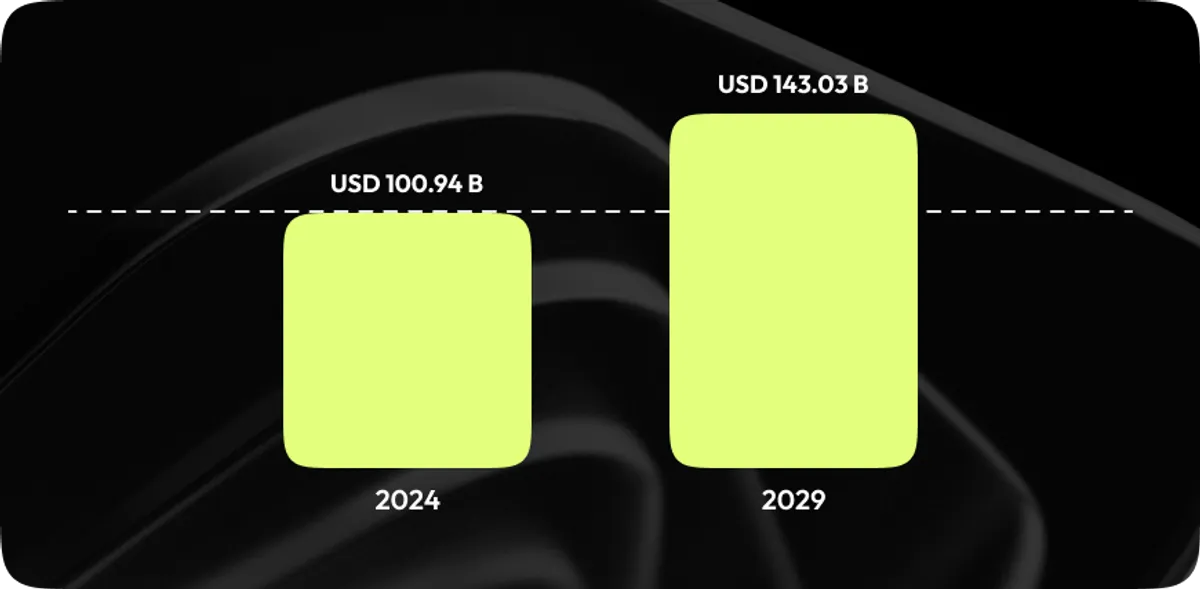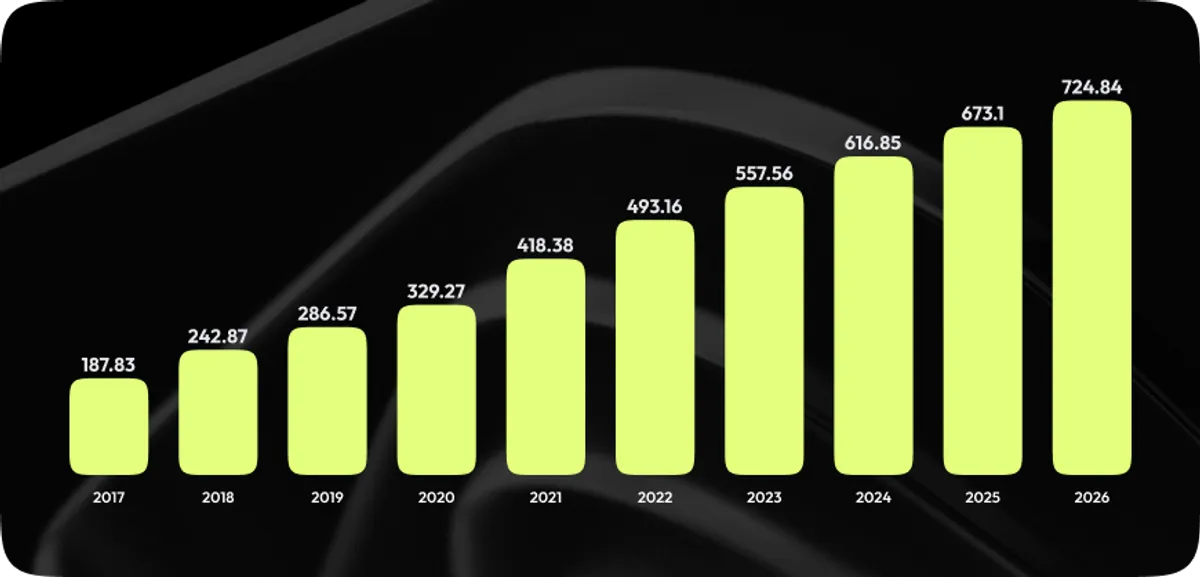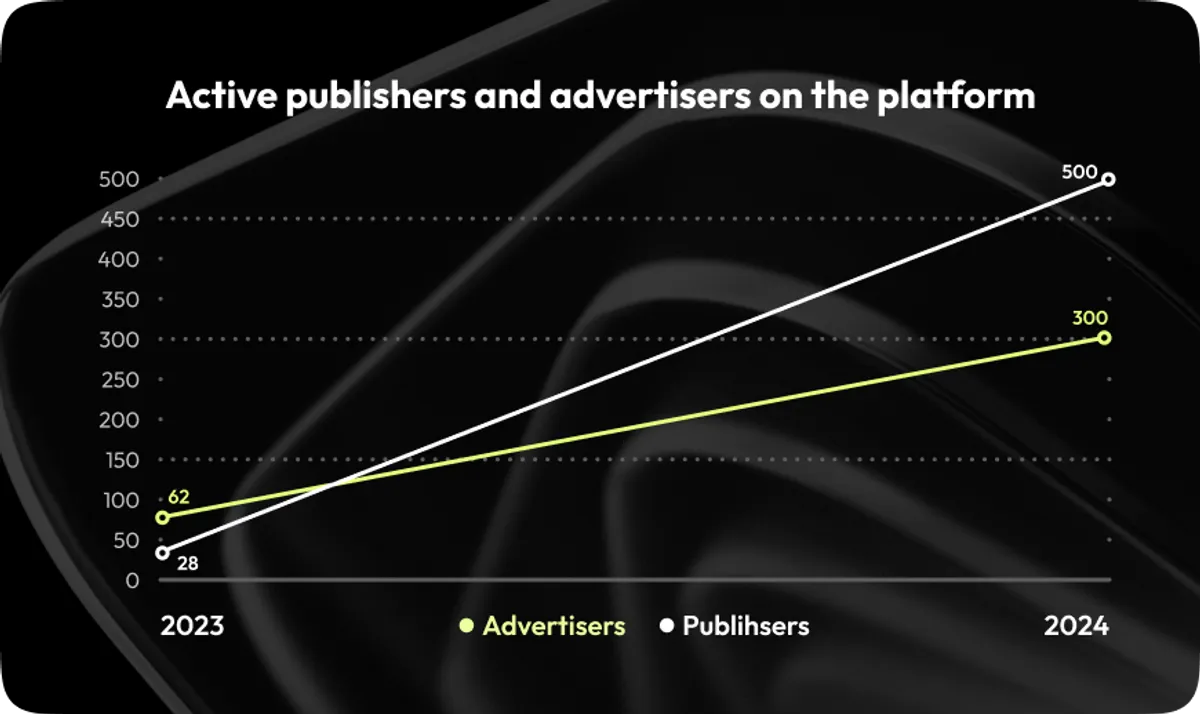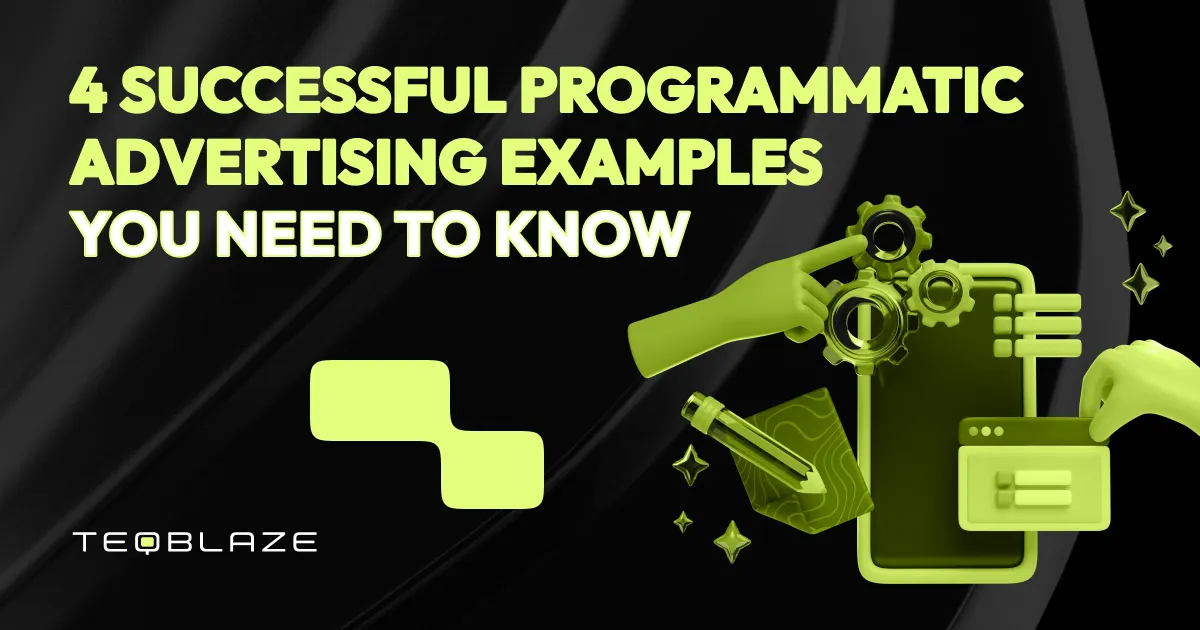Previously, to place advertisements on a particular website, advertisers had to contact the owners of inventory themselves, agree on the cost, ask for reports, and so on. This manual work was inconvenient and took a lot of time. Now all this is working smoothly with programmatic platforms.
Still, your ads can be creative, but they won't bring sales if the target audience or platform is not chosen correctly. Want to change the game and make your programmatic advertising campaigns work for you? In this article, TeqBlaze explores what programmatic advertising is, its types, and four programmatic examples of global companies that are already benefiting from it.
What is programmatic advertising: examples and market overview
Before the advent of programmatic, advertising placement required determining broadcast slots and calculating and purchasing impressions. This led to high costs and low reliability of the process, as the volume of traffic was unstable and negotiations on slots took a long time.
Programmatic advertising has completely reinvented this process by facilitating and speeding up the ad placement process. Automated auctions connect advertisers looking to purchase ad space online with website owners providing that digital space. Both parties utilize a programmatic platform. DSPs are represented by advertisers, and SSPs are characterized by website owners. Programmatic platforms accumulate the audience, segment it, and immediately show it to users.
For advertisers, programmatic is an opportunity to get a large reach through placements on various resources. And at the same time, all the processes are done in one place. In addition, the advantages of programmatic advertising are precise targeting and full automation of advertising purchases. Algorithms do everything independently, all you need to do is monitor the indicators and make adjustments, if necessary.
The European programmatic advertising market is valued at USD 100.94 Billion in 2024 and is projected to reach USD 143.03 Billion by 2029, growing at a CAGR of 7.22% during the period from 2024 to 2029.

In 2020, people spent $329 billion on programmatic advertising, and this indicator is projected to reach $724 billion in 2026.

From 2013 to 2024, programmatic ad spending has grown significantly on mobile and then expanded into CTV. Mobile programmatic advertising is now considered an excellent channel for expanding the reach and increasing user engagement rates. Imagine that in 2021 there were almost 1,090 million mobile subscribers in Europe, and this number is expected to increase to 1,110 million by 2027, as people are spending more time on their phones than on TVs.
According to an EMARKETER December 2023 prediction, US programmatic digital display ad spending raised from $4.99 billion to $135.72 billion within the same period. EMARKETER's April 2023 projection indicates that US programmatic video ad spending surpassed non-video digital display ad spending for the first time in 2022. Furthermore, spending on programmatic video ads is growing more quickly than on non-video. The increase in spending on video advertisements is primarily due to CTV, mobile, and social media advertising on sites such as TikTok. With the constant development of advertising platforms, new types of banners, and trends, publishers and advertisers often can’t cope with the flood of information alone. Programmatic advertising changes the entire process, automating it down to every detail. How exactly?
One of the areas where programmatic is transforming traditional approaches is local TV ads. With the integration of digital targeting into localized broadcasting, advertisers can now reach niche audiences at scale—on their connected TVs—while still leveraging geographic precision. This evolution brings the power of programmatic to an environment long dominated by manual placements and broad demographics.
How does programmatic advertising work?
The difference between programmatic and non-programmatic advertising lies in automation. With programmatic, media buying is conducted in real-time through automated bids. With non-programmatic methods, it's all manual negotiations and direct deals, which are often time-consuming and less efficient. To illustrate how automation streamlines the process, let's look at an example of how a real-time bidding (RTB) auction works in programmatic advertising.
Say a consumer navigates from a search to a page where an ad is displayed. The real-time display ad is auctioned through an exchange on a supply-side platform. The demand-side platform offers bids for the display according to audience targeting criteria. Whoever offers the highest bid wins. This ad is then placed on the website where the consumer goes. The process takes less than 10 seconds.
Programmatic advertising types
Programmatic advertising is often mistakenly confused with real-time bidding. While RTB is a significant component, it's one of several programmatic advertising methods we will discuss next.
Programmatic real-time bidding
This is the most common model that is used to purchase up to 90% of space. RTB is suitable for performance-based programmatic advertising campaigns when the main goal of advertising is traffic and conversions.
Programmatic direct
In this case, the advertiser communicates directly with the website during the transaction. The parties agree on a fixed price for placement. The direct model is used for branding programmatic advertising campaigns when it is necessary to increase recognition and image. The advertiser personally controls which website the ad will appear on.
Private exchange buying, or PMP
Like RTB, these ad exchange examples work on the principle of auctioning - the highest bid for inventory wins. But PMP bidding takes place on closed advertising exchanges - you can get to the auction only by invitation. It helps to remove intermediaries since the programmatic platform connects directly to the publisher's inventory. It also allows full control over the purchase, as the auction is not automated.
Private marketplace guaranteed, PMPG
This model differs from a regular private auction - you can purchase the entire inventory of a single marketplace.
Preferred deals
This model happens without auctions. In this case, the price for displaying an ad is fixed. As a rule, those websites that could not be sold through such deals then appear in the auction.
4 Insightful industry-specific examples of programmatic advertising
These real-world programmatic ads examples demonstrate the power of programmatic advertising in action.
Media: The Economist
The Economist's award-winning campaign delivered a huge return on investment.
Using the publication's content along with provocative, witty, or humorous headlines, the ads targeted readers whose cookies showed they didn't spend much time on the Economist's website.
The results were impressive. According to eConsultancy, they attracted 650,000 new potential customers, prompted 3.6 million people to take action, and delivered a campaign return on investment of 10:1 on a media budget of £1.2 million. This was accompanied by a 64% increase in awareness in the US and a 22% increase in conversions.
Hospitality: IHG
The parent firm of the Holiday Inn and Intercontinental chains, IHG, has started implementing programmatic advertising to entice customers to make direct reservations with them as opposed to using third-party advertising websites like Expedia or Booking.com. Since third-party websites in the travel sector might charge anywhere from 15% to 24% commission, direct spending can have a significant impact on hotels.
IHG's programmatic ad targeted consumers who were about to book a room with an ad that included a "book a room at a direct rate" option. As COO Matt Luscombe told Marketing Week, the campaign was a great success. "By utilizing advanced targeting capabilities through programmatic, we could find a wider range of people looking for accommodations and target them with our 'book direct' message." Buying a large number of banners online simply had an extremely effective splash effect."
"The hotel industry has woken up," Luscombe said, arguing that other hotel brands, including Hilton and Marriott, are following their company's lead.
Automotive: Audi
World-famous automaker Audi set out to further customize its marketing efforts in advance of the release of its "customizable" vehicle and created a campaign that lived true to its famous slogan, "Vorsprung durch Technik" ("Progress through Technology"). Working closely with Google, utilizing programmatic display advertising examples and Video 360, Audi took a data-driven approach that combined all customer data rather than relying on data. In this way, using programmatic methods, the marketing team was able to optimize the most valuable customer touchpoints.
In addition to collecting behavioral data to improve marketing segmentation, the brand offered users the opportunity to create their dream car online from 6,000 possible combinations. These custom designs were then used to create personalized, dynamic ads that doubled the effectiveness of standard ads. The programmatic ad buy resulted in a conversion rate four times higher than ads bought the traditional way.
Consumer goods: Unilever
The global consumer goods leader Unilever, which owns well-known brands including Ben & Jerry's, Hellmann, and Dove, has cleverly used programmatic video advertising to boost brand engagement and spur growth.
For example, the Dove brand of Unilever launched a programmatic video campaign centered on body positivity. By utilizing advanced data analytics tools, Dove identified target audiences for self-care and body-image-related content. The campaign featured diverse models in authentic settings, resonating deeply with viewers. Consequently, Dove witnessed a 25% surge in brand favorability and a 15% rise in buy intent within the intended audience.
Furthermore, Unilever's Hellmann brand used programmatic video to advertise its plant-based mayonnaise substitute. The campaign highlighted the product's tasty flavor and sustainable qualities, which increased online sales by 20% and video completion rates by 30%.
In comparison to traditional linear TV advertising, Unilever's use of programmatic video advertising has helped the company achieve a 30% improvement in return on ad spend. Through accurate audience targeting, real-time ad creative optimization, and campaign success monitoring, Unilever has proven that programmatic advertising can boost brand equity and propel business expansion.
All these real-world success stories demonstrate the effectiveness of programmatic advertising campaigns examples to target the right customers at the right time to achieve meaningful engagement and measurable conversions.
6 Best programmatic display examples
Let’s now go through specific programmatic advertising campaigns examples that brought remarkable results.
McDonald's dynamic creative optimization
McDonald's masterfully employed DCO as a programmatic buying example to create highly personalized ad experiences. Using real-time data on variables like location, weather, and time of day, the fast-food chain customized its ad creatives to appeal to a specific audience. For example, advertisements emphasized warming drinks and hearty food items on chilly days, and lighter meals and refreshing drinks on sunny ones.
Spotify's audience-based buying
Spotify, the top music streaming platform, used audience-based buying to provide highly targeted advertising experiences to its massive user base. Spotify offered adverts that exactly matched customers' interests after thoroughly assessing their listening patterns and choices. Their programmatic marketing examples resulted in a significant boost in ad engagement and conversion rates, indicating that users were more open to relevant and targeted messaging.
Amazon's product-based retargeting
Amazon has enhanced its product-based retargeting to drive sales and increase customer loyalty. By tracking users' browsing behavior on its platform, the company offered highly relevant product recommendations through display ads on other websites. The programmatic display ads examples effectively reminded customers of items they had shown interest in, leading to increased purchase conversions and higher average order values.
Burberry's contextual advertising
Burberry, a luxury apparel brand, excelled at contextual advertising by placing adverts on premium websites that were relevant to its brand image and target audience. In such a way, the brand guaranteed that its advertisements reached a highly engaged audience by carefully selecting websites with information connected to fashion, luxury lifestyles, and high-end travel. This programmatic buying example helped to maintain the brand's exclusivity while increasing brand awareness.
L'Oréal's video ad sequencing
L'Oréal, a global beauty leader, created a compelling brand narrative through video ad sequencing. By delivering a series of interconnected video ads, L'Oréal effectively communicated its brand story and product benefits. Their programmatic video examples drove product consideration and ultimately influenced purchase decisions.
GEICO's geotargeting
Amazon has refined product-based remarketing to boost sales and consumer loyalty. Amazon provided highly relevant product recommendations to consumers on other websites by tracking their browsing behavior on its platform. This location-based method boosted ad relevance and effectiveness, leading to higher conversion rates and improved customer acquisition.
Why choose a custom DSP platform?
If you work with specific publishers or non-typical inventory, it can be difficult to find a solution on the market that meets your business needs. When we talk about programmatic advertising, developing and creating your platform may be an optimal option.
TeqBlaze, among other examples of programmatic advertising platforms, focuses exclusively on empowering businesses through customizable programmatic advertising technology. With the pre-built AdTech platform, you can connect any solution that your publisher has. By providing you with various advertising types and devices, you can enter or expand the digital advertising market without the complexities and costs.
Experience our flexible & customizable white-label programmatic platform
Analyzing the case studies listed above, programmatic advertising positions itself as a tool that makes life easier for marketers and contextual advertising specialists by saving time and effort. The advantage of programmatic advertising campaigns is that they can be added to an existing promotion strategy as an additional channel. One of the prominent programmatic advertising examples features the White-Label DSP+SSP Bundle from TeqBlaze.
TeqBlaze collaborated with a dynamic startup specializing in privacy-centric programmatic advertising. The client sought to consolidate two independent programmatic platforms into a unified solution capable of delivering innovative contextual targeting without relying on third-party cookies. TeqBlaze integrated the client's contextual intelligence tool into the core platform technology, enabling precise audience targeting while maintaining user privacy. Additionally, we developed custom functionalities to support a range of innovative ad formats, including Al-Driven Banner, In-Screen, In-Image, and In-Video.
The result is a scalable solution for publishers and advertisers, empowering them to maximize revenue and deliver engaging ad experiences. Through this partnership, the client has expanded its user base from 28 publishers and 62 advertisers to 500 publishers and 300 advertisers within the first year of deployment. The company also achieved a significant milestone, recording a net income of USD 17,000 during this period.

With extensive experience in the programmatic environment, we can help you improve your programmatic advertising campaigns for the continued success of your business. Book a demo to fuel your AdTech platform with exclusive programmatic solutions.

 Anna Vintsevska
Anna Vintsevska





